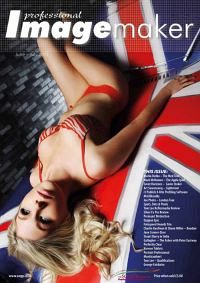articles/Lighting/fakingit-page2
Lighting for digital Dave Montizambert Faking It - part 2 of 1 2 3 4
by Dave Montizambert Published 01/06/2011
From the opposite side of the seamless, another light fitted with its parabolic reflector was added, see Image 004. This light requires a frosted acetate diffusion gel such as a Roscolux Tuff-Frost gel, but does not need the blue gel. This strobe head was aimed so that its light energy spreads evenly across the seamless backdrop, as we did with the blue light. The power of this light source was set to give a +1 to +2 reflective meter reading across the white seamless' surface. You may be thinking that the addition of this white light completely overpowers the blue light making the blue light seem pointless but we are not done yet - a cucolouris also called a "cookie" needs to be added to selectively block some of the white light from the background so that the "blue sky" can selectively show through, see Images 001 and 004. A cucolouris is usually a rectangular piece of card or thin plywood with shapes cut into it, but for this background effect I instead opted for a branch full of leaves. The leaves serve to selectively block the light as does a traditional cucolouris, but the leaves make for more believable clouds because they are at different distances from the light source giving greater depth in the skyscape, whereas the shapes cut in the card or board of the cucolouris are all on the same plane. Also the leaves are not rigid and can be individually moved to better shape the projected shadows on the background. Controlling how soft edged the shadows are is paramount for this lighting effect to look believable
Studio strobe preview:DID YOU KNOW? A modeling light is really a preview light on a strobe (flash) head. It is usually positioned with the strobe tube wrapped around it and it has a similar light coverage as the strobe tube. Since the strobe only creates light for a fraction of a second you cannot see its effect by eye on the subject. A modeling light is constant light instead of a burst of light, it allows you to see a close approximation of what the strobe will do. When creating shadow effects on a background, be aware the modeling light tungsten bulb is not exactly the same as the strobe tube and so the projected shadows can appear a little different on the background when compared with how they look in an actual capture. This is easily fixed by adding some diffusion material over the light source (use a heat- and fire-resistant material like Roscolux Tuff-frost to prevent fires) making the shadows created with the modeling bulb look the same as the shadows created with the strobe tube.
Please Note:
There is more than one page for this Article.
You are currently on page 2
- Lighting for digital Dave Montizambert Faking It page 1
- Lighting for digital Dave Montizambert Faking It page 2
- Lighting for digital Dave Montizambert Faking It page 3
- Lighting for digital Dave Montizambert Faking It page 4
1st Published 01/06/2011
last update 09/12/2022 14:54:07
More Lighting Articles
There are 0 days to get ready for The Society of Photographers Convention and Trade Show at The Novotel London West, Hammersmith ...
which starts on Wednesday 15th January 2025





